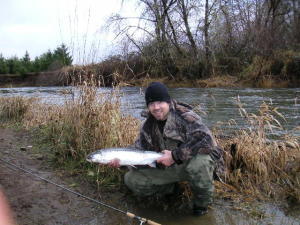Post
Fishing for Vagabond Steelhead
California Fishing Articles, Freshwater Fishing Tips, Regional Fishing, Tackle Tips & How To's, United States Fishing Articles | California theangler PM

Steelhead, which moves into the streams of the north state on a timetable all their own, are the true vagabonds of the fishing world. Finding the runs becomes more difficult than actually catching the silvery fish.
The Klamath River (northwest California and part of Oregon) offers anglers the best chance of locating runs of steelheads during the fall when hordes of fish move from the Pacific toward their spawning creeks within the Klamath drainage.
Steelhead is a much better target in the Klamath River system than are salmon. When steelhead moves through the lower river, they are able to elude the nets. This allows virtually all of them to survive and move up the river.
Klamath steelhead has not suffered like salmon because steelies do their spawning in the river’s smaller tributaries. Salmon demand spawning in the main stem, where habitat has eroded for 50 years due to logging and forest development.
Fishing logs show the first steelies appear in the lower river in August and September; reports from streamside confirm this, with steelhead in fishable numbers upstream as far as Seiad Valley, where they find fresh, cool water near the mouths of tributary creeks.
Rains in September may be the best thing that happens for Klamath steel headers. If the flows are increased enough, steelhead moves into the upper sections of the river above Ti Bar. When the showers suddenly stop, steelhead fishermen find the fish stacked up in all the pools and riffles in the central Klamath.
An informal timetable for dates when steelies arrive reads like this: Blue Creek to Johnson’s, September 1; Weitchpec, (mouth of Trinity River), Sept. 7-15; Orleans to Somesbar, September 20; Happy Camp, October 1; Happy Camp to Hamburg, October 15; Hamburg to Iron Gate, Oct. 20-30. The steelhead genuinely runs right on schedule.Even without storms, flows in the Klamath are increased during the first week of each month; this additional flow makes the fish restless and they start to move and hit. When the water is freshened by increased flows, it is time to offer the fish flies. The most successful of the modern generation are those cast with a spinning rig and a plastic Adjusta-Bubble.
The casting bubbles are hollow and can be loaded with enough water inside to cast across most of the better water in the Klamath. The water in the bubbles then sinks it and the fly to the bottom, where steelhead traditionally holds.Although every fly ever designed has had some success, the Klamath has two particularly productive patterns. Silver Hilton, with black chenille body, gray hackle, wings and tails, and the Brindle Bug, with olive chenille body and brown hackle and tail, are two patterns standard for all clear-water Klamath fishing.Fly size Nos. 8 through 2 are the only ones needed. In general, use larger flies and darker colors when the water is roiled, and smaller, brighter patterns in clear flows.
A fly fisherman can score using a No. 7 to 10 weight, fast-sinking line.1
You can also try a High-D Shooting Head that gets deep in a heavy flow. Most Klamath fly rods are nine-footers.
A lure fisherman can offer any spinner, wobbler or vibrating plug and take at least some steelhead. However, a good idea is to rig so the sinker can break off. The river is notorious for big rocks that make wading difficult and cause hundreds of snag-ups each day.
It’s difficult for new steel headers to realize the automobile is as important a part of fishing gear as the rod and reel. The Klamath has a road, Highway 96, running along its bank except for the stretch below the mouth of the Trinity River. A good idea is to drive along the river until you find other fishermen at work. It’s an odd day when a newcomer finds a run of steelies missed by local sharpies.
